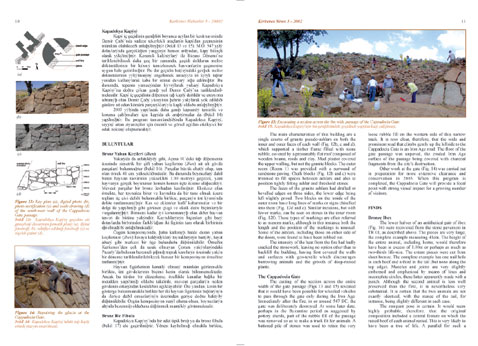EXCAVATIONS
The Cappadocia Gate
The
cutting of the section across the entire width of the gate passage
(Figs 13
and 15) revealed
that it would have been possible for wheeled vehicles to pass
through the gate only during the Iron Age. Immediately after
the fire, in or around 547 BC, the gate was deliberately destroyed.
At some later date, perhaps in the Byzantine period as suggested
by pottery sherds, part of the rubble fill of the passage was
removed so as to make a track fit for animals. A battered pile
of stones was used to retain the very loose rubble fill on the
western side of this narrow track. It is now clear, therefore,
that the wide and prominent road that climbs gently up the hillside
to the Cappadocia Gate is an Iron Age road. The floor of the
gate passage was unpaved, the eroded Iron Age surface of the
passage being covered with charcoal fragments from the city's
destruction.
Other
work at the gate (Fig.
14) was carried out in preparation for more extensive
clearance and conservation in 2003. When this program is completed,
the Cappadocia Gate will provide a focal point with strong visual
impact for a growing number of visitors.
FINDS
Bronze Ibex
The
lower halves of an antithetical pair of ibex (Fig.
16) were recovered from the stone pavement in TR 01, as
described above. The pieces are very large, the complete example
measuring 41cm. The height of the entire animal, including horns,
would therefore have been in excess of 1.00m or perhaps as much
as two-thirds life-size. The extant pieces were cut from sheet
bronze. The complete example has one nail hole in each hoof
and a third in the tail (but none along the top edge). Muscles
and joints are very slightly embossed and emphasized by means
of lines and incomplete circles, these latter apparently made
with a punch. Although the second animal is less well preserved
than the first, it is nevertheless very substantial. It is certain
that the two animals are not exactly identical, with the stance
of the tail, for instance, being slightly different in each
case.
The
rampant pose is certain. It would seem highly probable, therefore,
that the original composition included a central feature on
which the raised hoof of each animal rested. This is very likely
to have been a tree of life. A parallel for such a composition
that is not far distant from Kerkenes, and perhaps not very
much later in date, can be seen on the decorated terracotta
tiles from Pazarli near Çorum.
It
is possible, but by no means certain, that the animals were
winged. Such an arrangement would perhaps go some way to explaining
why the extant pieces end across the middle of the torso, particularly
if the wings were made of a different material. It is likewise
possible, but by no means necessary, to imagine that both animals
were looking back over their shoulders rather than facing forwards.
Whatever the original composition, it seems more than reasonable
to assume that the horns were emblazoned with gold.



